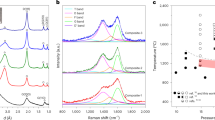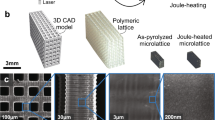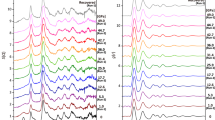Abstract
The creation of materials with a combination of high strength, substantial deformability and ductility, large elastic limit and low density represents a long-standing challenge, because these properties are, in general, mutually exclusive. Using a combination of two-photon lithography and high-temperature pyrolysis, we have created micro-sized pyrolytic carbon with a tensile strength of 1.60 ± 0.55 GPa, a compressive strength approaching the theoretical limit of ~13.7 GPa, a substantial elastic limit of 20–30% and a low density of ~1.4 g cm−3. This corresponds to a specific compressive strength of 9.79 GPa cm3 g−1, a value that surpasses that of nearly all existing structural materials. Pillars with diameters below 2.3 μm exhibit rubber-like behaviour and sustain a compressive strain of ~50% without catastrophic failure; larger ones exhibit brittle fracture at a strain of ~20%. Large-scale atomistic simulations reveal that this combination of beneficial mechanical properties is enabled by the local deformation of 1 nm curled graphene fragments within the pyrolytic carbon microstructure, the interactions among neighbouring fragments and the presence of covalent carbon–carbon bonds.
This is a preview of subscription content, access via your institution
Access options
Access Nature and 54 other Nature Portfolio journals
Get Nature+, our best-value online-access subscription
$29.99 / 30 days
cancel any time
Subscribe to this journal
Receive 12 print issues and online access
$259.00 per year
only $21.58 per issue
Buy this article
- Purchase on Springer Link
- Instant access to full article PDF
Prices may be subject to local taxes which are calculated during checkout





Similar content being viewed by others
Data availability
The data that support the plots and other findings of this study are available from the corresponding authors upon request.
References
Meyers, M. A. & Chawla, K. K. Mechanical Behavior of Materials (Cambridge Univ. Press, 2009).
Ashby, M. F. in Materials Selection in Mechanical Design 4th edn, Ch. 4, 57–96 (Butterworth-Heinemann, 2011).
Muth, J. T., Dixon, P. G., Woish, L., Gibson, L. J. & Lewis, J. A. Architected cellular ceramics with tailored stiffness via direct foam writing. Proc. Natl Acad. Sci. USA 114, 1832–1837 (2017).
Lucas, R., Meza, L. R., Das, S. & Greer, J. R. Strong, lightweight and recoverable three-dimensional ceramic nanolattices. Science 345, 1322–1326 (2014).
Wang, H. et al. Ultralight, scalable and high-temperature-resilient ceramic nanofiber sponges. Sci. Adv. 3, e1603170 (2017).
Lu, L., Shen, Y., Chen, X., Qian, L. & Lu, K. Ultrahigh strength and high electrical conductivity in copper. Science 304, 422–426 (2004).
Sanders, P. G., Eastman, J. A. & Weertman, J. R. Elastic and tensile behavior of nanocrystalline copper and palladium. Acta Mater. 45, 4019–4025 (1997).
Zhang, Y. et al. Microstructures and properties of high-entropy alloys. Prog. Mater. Sci. 61, 1–93 (2014).
Greer, J. R. & Hosson, J. T. Plasticity in small-sized metallic systems: intrinsic versus extrinsic size effect. Prog. Mater. Sci. 56, 654–724 (2011).
Wu, B., Heidelberg, A. & Boland, J. J. Mechanical properties of ultrahigh-strength gold nanowires. Nat. Mater. 4, 525–529 (2005).
Lowry, M. B. et al. Achieving the ideal strength in annealed molybdenum nanopillars. Acta Mater. 58, 5160–5167 (2010).
Gogotsi, Y. Not just graphene: the wonderful world of carbon and related nanomaterials. MRS Bull. 40, 1110–1121 (2015).
Lee, C., Wei, X., Kysar, J. W. & Hone, J. Measurement of the elastic properties and intrinsic strength of monolayer graphene. Science 321, 385–388 (2008).
Rasool, H. I., Ophus, C., Klug, W. S., Zettl, A. & Gimzewski, J. K. Measurement of the intrinsic strength of crystalline and polycrystalline graphene. Nat. Commun. 4, 2811 (2013).
Zhang, P. et al. Fracture toughness of graphene. Nat. Commun. 5, 3782 (2014).
Wei, Y. et al. The nature of strength enhancement and weakening by pentagon–heptagon defects in graphene. Nat. Mater. 11, 759–763 (2012).
Song, Z., Artyukhov, V. I., Wu, J., Yakobson, B. I. & Xu, Z. Defect-detriment to graphene strength is concealed by local probe: the topological and geometrical effects. ACS Nano 9, 401–408 (2015).
Cao, A., Dickrell, P. L., Sawyer, W. G., Ghasemi-Nejhad, M. N. & Ajayan, P. M. Super-compressible foam-like carbon nanotube films. Science 310, 1307–1310 (2005).
Qu, L., Dai, L., Stone, M., Xia, Z. & Wang, Z. L. Carbon nanotube arrays with strong shear binding-on and easy normal lifting-off. Science 322, 238–242 (2008).
Barg, S. et al. Mesoscale assembly of chemically modified graphene into complex cellular networks. Nat. Commun. 5, 4328 (2014).
Qin, Z., Jung, G. S., Kang, M. J. & Buehler, M. J. The mechanics and design of a lightweight three-dimensional graphene assembly. Sci. Adv. 3, e1601536 (2017).
Zhang, H., Lopez-Honorato, E. & Xiao, P. Fluidized bed chemical vapor deposition of pyrolytic carbon-III. Relationship between microstructure and mechanical properties. Carbon 91, 346–357 (2015).
Stein, I. Y. et al. Structure–mechanical property relations of non-graphitizing pyrolytic carbon synthesized at low temperatures. Carbon 117, 411–420 (2017).
Zhao, Z. et al. Nanoarchitectured materials composed of fullerene-like spheroids and disordered graphene layers with tunable mechanical properties. Nat. Commun. 6, 6212 (2015).
Hu, M. et al. Compressed glassy carbon: an ultrastrong and elastic interpenetrating graphene network. Sci. Adv. 3, e1603213 (2017).
Bauer, J., Schroer, A., Schwaiger, R. & Kraft, O. Approaching theoretical strength in glassy carbon nanolattices. Nat. Mater. 15, 438–443 (2016).
Li, X. & Gao, H. Mechanical metamaterials: smaller and stronger. Nat. Mater. 15, 373–374 (2016).
Harris, P. J. New perspectives on the structure of graphitic carbons. Crit. Rev. Solid State 30, 235–253 (2005).
Cançado, G. L. et al. General equation for the determination of the crystallite size of nanographite by Raman spectroscopy. Appl. Phys. Lett. 88, 163106 (2006).
Bruley, J., Williams, D. B., Cuomo, J. J. & Pappas, D. P. Quantitative near-edge structure analysis of diamond-like carbon in the electron microscope using a two-window method. J. Microsc. 180, 22–32 (1995).
Basu, B., Tiwari, D., Kundu, D. & Prasad, R. Is Weibull distribution the most appropriate statistical strength distribution for brittle materials? Ceram. Int. 35, 237–246 (2009).
Bazant, Z. P. & Xiang, Y. Size effect in compression fracture: splitting crack band propagation. J. Eng. Mech. 13, 162–172 (1997).
Zhao, J. X., Bradt, R. C. & Walker, P. L. The fracture toughness of glassy carbons at elevated temperatures. Carbon 23, 15–18 (1985).
Yajima, S., Hirai, T. & Hayase, T. Micro-hardness of pyrolytic graphite and siliconated pyrolytic graphite. Tanso 69, 41–47 (1972).
Oku, T., Kurumada, A., Imamura, Y. & Ishihara, M. Effects of ion irradiation on the hardness properties of graphites and C/C composites by indentation tests. J. Nucl. Mater. 381, 92–97 (2008).
Dikin, D. et al. Preparation and characterization of graphene oxide paper. Nature 448, 457–460 (2007).
Jang, D., Li, X., Gao, H. & Greer, J. R. Deformation mechanisms in nanotwinned metal nanopillars. Nat. Nanotechnol. 7, 594–601 (2012).
Greer, J. R., Oliver, W. C. & Nix, W. D. Size dependence of mechanical properties of gold at the micron scale in the absence of strain gradients. Acta Mater. 53, 1821–1830 (2005).
Fu, S. Y., Lauke, B., Mäder, E., Yue, C. Y. & Hu, X. Tensile properties of short-glass-fiber- and short-carbon-fiber-reinforced polypropylene composites. Compos. Part A 31, 1117–1125 (2000).
Dunlay, W. A., Tracy, C. A. & Perrone, P. J. A Proposed Uniaxial Compression Test for High Strength Ceramics (US Army, 1989).
Wheeler, J. M. et al. Approaching the limits of strength: measuring the uniaxial compressive strength of diamond at small scales. Nano Lett. 16, 812–816 (2016).
Xu, B. & Tian, Y. High pressure synthesis of nanotwinned ultrahard materials. Acta Phys. Sin. 66, 036201 (2017).
Lai, A., Du, Z., Gan, C. L. & Schuh, C. A. Shape memory and superelastic ceramics at small scales. Science 341, 1505–1508 (2013).
Dusoe, K. J. et al. Ultrahigh elastic strain energy storage in metal-oxide-infiltrated patterned hybrid polymer nanocomposites. Nano Lett. 17, 7416–7423 (2017).
Mayer, J., Giannuzzi, L. A., Kamino, T. & Michael, J. TEM sample preparation and FIB-induced damage. MRS Bull. 32, 400–407 (2007).
Ke, X. et al. TEM sample preparation by FIB for carbon nanotube interconnects. Ultramicroscopy 109, 1353–1359 (2009).
Schaffer, M., Schaffer, B. & Ramasse, Q. Sample preparation for atomic-resolution STEM at low voltages by FIB. Ultramicroscopy 114, 62–71 (2012).
Jennings, A. T. & Greer, J. R. Tensile deformation of electroplated copper nanopillars. Philos. Mag. 91, 1108–1120 (2011).
Sadezky, A., Muckenhuber, H., Grothe, H., Niessner, R. & Pöschl, U. Raman microspectroscopy of soot and related carbonaceous materials: spectral analysis and structural information. Carbon 43, 1731–1742 (2005).
Plimpton, S. Fast parallel algorithms for short-range molecular dynamics. J. Comp. Phys. 117, 1–19 (1995).
Stuart, S. J., Tutein, A. B. & Harrison, J. A. A reactive potential for hydrocarbons with intermolecular interactions. J. Chem. Phys. 112, 6472–6486 (2000).
Deringer, V. L. & Csanyi, G. Machine learning based interatomic potential for amorphous carbon. Phys. Rev. B 95, 094203 (2017).
Acknowledgements
X.L. acknowledges financial support from the National Natural Science Foundation of China (grants 11522218 and 11720101002) and the National Basic Research of China (grant 2015CB932500). H.G. acknowledges funding from the National Science Foundation (grant DMR-1709318). J.R.G. acknowledges financial support by the US Department of Energy, Office of Basic Energy Sciences (DOE-BES) under grant DE-SC0006599. A.V. acknowledges the financial support of the Resnick Sustainability Institute at Caltech. The authors thank G. R. Rossman for assistance with Raman spectroscopy measurements, J. Yao for help with SIMS measurements and K. Narita for assistance with density measurements of pyrolytic carbon.
Author information
Authors and Affiliations
Contributions
X.Z., X.L., H.G. and J.R.G. conceived and designed the experiments and modelling. X.Z. and A.M. synthesized the experimental samples. X.Z. performed the in situ and ex situ compression experiments. A.M. performed the in situ tension experiments. A.K. and X.Z. performed the HRTEM and EELS analyses. A.V. and L.Z. performed the Raman spectroscopy measurements. L.Z. conducted the atomistic simulations. X.Z., L.Z. and X.L. developed the model. X.Z., L.Z., X.L., H.G. and J.R.G. wrote the manuscript. All authors analysed the data, discussed the results and commented on the manuscript.
Corresponding authors
Ethics declarations
Competing interests
The authors declare no competing interests.
Additional information
Peer review information: Nature Nanotechnology thanks Maria Pantano, Ping Xiao and other anonymous reviewer(s) for their contribution to the peer review of this work.
Publisher’s note: Springer Nature remains neutral with regard to jurisdictional claims in published maps and institutional affiliations.
Supplementary information
Supplementary Information
Supplementary text 1–5 Supplementary Figs. 1–20 Supplementary Figs. 1–20 Supplementary Table 1 Supplementary Table 1
Supplementary Video 1
In situ compression of 2.25-μm-diameter PyC micropillar
Supplementary Video 2
In situ tension of 1.5-μm-diameter PyC micropillar
Supplementary Video 3
Atomistic simulation of uniaxial compression on a 20-nm-diameter PyC nanopillar
Supplementary Video 4
Atomistic simulation of uniaxial tension of a 20-nm-diameter PyC nanopillar
Rights and permissions
About this article
Cite this article
Zhang, X., Zhong, L., Mateos, A. et al. Theoretical strength and rubber-like behaviour in micro-sized pyrolytic carbon. Nat. Nanotechnol. 14, 762–769 (2019). https://doi.org/10.1038/s41565-019-0486-y
Received:
Accepted:
Published:
Issue Date:
DOI: https://doi.org/10.1038/s41565-019-0486-y
This article is cited by
-
Three dimensional architected thermoelectric devices with high toughness and power conversion efficiency
Nature Communications (2023)
-
Ultrastrong conductive in situ composite composed of nanodiamond incoherently embedded in disordered multilayer graphene
Nature Materials (2023)
-
Pick and place process for uniform shrinking of 3D printed micro- and nano-architected materials
Nature Communications (2023)
-
Significant tensile elasticity of nanoscale boron arsenide
Science China Materials (2023)
-
A review of carbon-based materials and their coating techniques for biomedical implants applications
Carbon Letters (2023)



